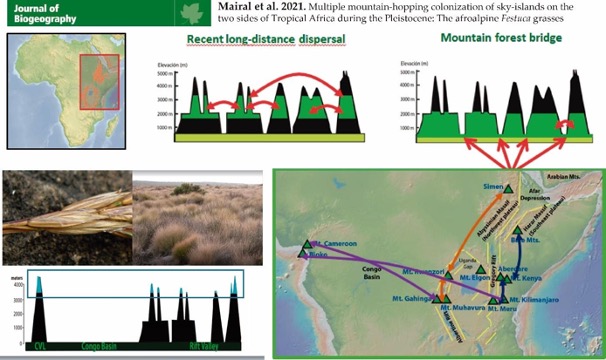Mairal, M. , Namaganda, M., Gizaw, A., Chala, D., Brochmann, C., Catalán, P.
Multiple mountain-hopping colonization of sky-islands on the two sides of Tropical Africa during the Pleistocene: The afroalpine Festuca grasses.
(2021) Journal of Biogeography, 48 (8), pp. 1858-1874.
DOI: 10.1111/jbi.14117
RESUMEN
Are there biogeographic connections between sky-islands at the extremes of Africa? Eastern and western African mountains represent one of the most isolated mountain systems in the world, a mosaic of scattered high-altitude peaks and plateaus separated by the Congo Basin and the Sahara Desert. Despite this, they share many barely known connections. The colonization of these mountains has been alternatively explained by 1) long-distance dispersal or 2) via forest reconnections (Montane Forest bridge hypothesis), when the vegetation belt descended 1,500 m during the glacial phases. To discern among hypotheses, we examine patterns of genetic diversity and phylogeographic history of the widespread Afroalpine Festuca species found on both the eastern and the western Tropical African sky-islands. We detected multiple long‐distance dispersals among the eastern African sky‐islands, and at least two dispersal events between the two sides of Africa (0.86 Ma and 0.52 Ma), probably facilitated by bridging suitable habitats during the coldest periods of the Pleistocene. We reconstruct an “Afroalpine mountain‐hopping dispersal model”, with migrations occurring between adjacent sky‐islands in eastern Africa, and through a Central Africa–Sudan pathway connecting Afroalpine patches on the two sides of the continent.
